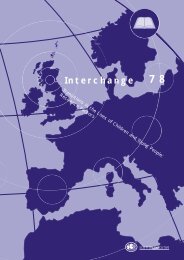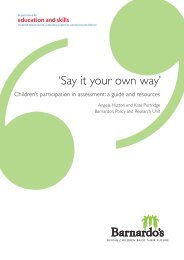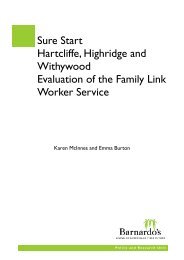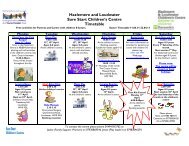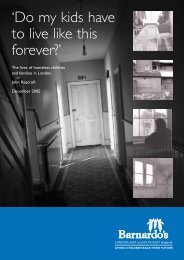Splintered Lives - Barnardo's
Splintered Lives - Barnardo's
Splintered Lives - Barnardo's
Create successful ePaper yourself
Turn your PDF publications into a flip-book with our unique Google optimized e-Paper software.
PAGE 56<br />
chapter<br />
8<br />
(p660). Childhood stress responses like bed wetting, disturbed sleep, and mood<br />
changes were also common.<br />
They develop a typology of adaptional responses (how the children and young people<br />
are making sense of and coping with abuse), based on the different current situations of<br />
the children.<br />
Integration is where the child neither avoids nor is unduly preoccupied by talking<br />
about their experiences. They are able to attribute responsibility to the adults<br />
involved, and can look towards and think about the future. Slightly more than a<br />
quarter of the children were in this group.<br />
Avoidance is where the child still denies aspects of what happened and is still<br />
afraid of the offender/so They live in the present, and many of their relationships<br />
with others are strained. A further quarter of the children were in this group.<br />
Repetition involves ongoing chronic distress, which is either a cumulative reaction<br />
to prior abuse or the outcome of subsequent abuse (three boys and three girls in<br />
this group were currently involved prostitution). These children are anxious, blame<br />
themselves, and cannot control intrusive memories or thoughts. They are oriented<br />
towards the past and feel hopeless about the future. Again, further quarter were in<br />
this group.<br />
Identification with the exploiter, here children attempt to impersonate the<br />
aggressor, transforming themselves from the one threatened to the threatener. They<br />
exploit others, minimise the abuse in the past and present, and resent interference<br />
from others. They often maintain emotional, social and economic ties with the<br />
offender and will be sorry and/or angry about their exposure or conviction. They are<br />
orientated only to the present. Slightly less than a quarter were in this group. Five<br />
had abused other children, and six were known to have committed other indictable<br />
crimes; three were working as pimps, and two had joined fascist-type organisations.<br />
The length of involvement in the ring significantly connected to outcomes: "Children<br />
involved... for less than a year had about a 50% chance of integrating the experience or<br />
avoiding the event two years later, while children in the rings more than a year had a<br />
three to one chance of remaining symptomatic or identifying with the exploiter" (p661).<br />
Being involved in the production of pornography increased the likelihood of identifying<br />
with the exploiter, especially when it was coupled with more than a year's involvement.<br />
Michael Hames said that in his experience the main additional consequence for a child<br />
of involvement in pornography is fear and anxiety that it is in the world and that others<br />
will be watching it. Some live in terror that they will be recognised, and most are<br />
preoccupied by where the material has gone. Hunt and Baird (1990) confirm this, whilst<br />
noting the limited work to date on the impacts of child pornography on the children<br />
used in it:






